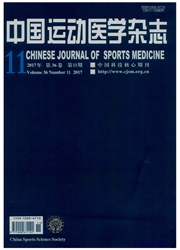

 中文摘要:
中文摘要:
目的:从红细胞造血生长因子的角度探讨运动性贫血的发生机理。方法:以30只雄性Wistar大鼠为实验对象,进行为期11周的实验控制,通过对大鼠实施递增负荷跑台运动建立运动性贫血模型。大鼠随机分为3组:对照组(10只)、递增负荷跑台运动组(运动组,10只)、递增负荷跑台运动+营养补充组(运动+营养组,第5周结束时即大鼠运动性贫血模型成功建立后进行营养补充,10只),应用大鼠专用ELISA试剂盒测试三组大鼠血清造血生长因子白细胞介素3(IL-3)、粒细胞集落刺激因子(G-CSF)、粒一单核细胞集落刺激因子(GM-CSF)的含量。结果:运动组大鼠血清G-CSF水平显著高于对照组(P〈0.05),运动+营养组与对照组相比无显著性差异(P〉0.05),而GM-CSF、IL-3含量则无明显组间差异。结果提示,运动性贫血的发生可能与G-CSF的功能相关,而营养牢补充对大鼠血清三种造血生长因子影响不明显。
 英文摘要:
英文摘要:
Objective The study was to investigate the mechanism of exercise - induced anemia mainly through the hemopoietic growth factors of erythrocyte. Methods Thirty male Wistar rats started with long - term treadmill exercise with incremental loading to establish model of exercise - induced anemia. After developing the model, they were divided into three groups: control group (n -- 10), exercise group (Ex, n = 10) and exercise plus nutrition group (Ex + Ad,n=10). Hemopoietic growth factors concentration, such as IL- 3, G - CSF and GM - CSF of serum in rats were quantified by enzyme - linked immunosorbent assay (ELISA) . Results Under anemic condition, the G- CSF level in Ex group was significantly higher than that in control group ( P 〉 0.05), while there was no significant difference between Ex + Ad group and control group ( P 〉 0.05) . However, no significant differences in GM - CSF, and IL - 3 were found among the three groups. Conclusion G- CSF hemopoietic growth factors probably was related with the mechanism of sports anemia in rats, but nutrition administration have not significant effects on the three serum bioactivities of hemopoietic growth factors.
 同期刊论文项目
同期刊论文项目
 同项目期刊论文
同项目期刊论文
 期刊信息
期刊信息
